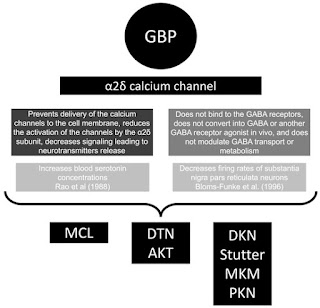Article type: Literature Review
Article title: Gabapentin-Associated Movement Disorders: A Literature Review
Journal: Medicines
Year: 2023
Authors: Jamir Pitton Rissardo, Ursula Medeiros Araujo de Matos, and Ana Letícia Fornari Caprara
E-mail: jamirrissardo@gmail.com
ABSTRACT
Background: Gabapentin (GBP)-induced movement disorders (MDs) are under-recognized adverse drug reactions. They are commonly not discussed with patients, and their sudden occurrence can lead to misdiagnosis. This literature review aims to evaluate the clinical–epidemiological profile, pathological mechanisms, and management of GBP-associated MD. Methods: Two reviewers identified and assessed relevant reports in six databases without language restriction between 1990 and 2023. Results: A total of 99 reports of 204 individuals who developed a MD associated with GBP were identified. The MDs encountered were 135 myoclonus, 22 dyskinesias, 7 dystonia, 3 akathisia, 3 stutterings, 1 myokymia, and 1 parkinsonism. The mean and median ages were 54.54 (SD: 17.79) and 57 years (age range: 10–89), respectively. Subjects were predominantly male (53.57%). The mean and median doses of GBP when the MD occurred were 1324.66 (SD: 1117.66) and 1033 mg/daily (GBP dose range: 100–9600), respectively. The mean time from GBP-onset to GBP-associated MD was 4.58 weeks (SD: 8.08). The mean recovery time after MD treatment was 4.17 days (SD: 4.87). The MD management involved GBP discontinuation. A total of 82.5% of the individuals had a full recovery in the follow-up period. Conclusions: Myoclonus (GRADE A) and dyskinesia (GRADE C) were the most common movement disorders associated with GBP.
Keywords: neurontin; ci-945; goe-3450; dm-1796; movement disorder; myoclonus; dyskinesia; seizure; side effect; neuropathy
Full text available at:
DOI
10.3390/medicines10090052
Citation
Rissardo JP, Matos UMA, Fornari Caprara AL. Gabapentin-Associated Movement Disorders: A Literature Review. Medicines 2023;10:52.
Figure 2. Flowchart of the screening process.
Figure 3. Line graph showing the cumulative number of publications regarding gabapentin-associated movement disorder from 1990 to 2023. AKT, akathisia; DKN, dyskinesia; DTN, dystonia; MCL, myoclonus; MKM, myokymia; PKN, parkinsonism. In the “Others” subgroup are cases not specified about the movement disorder, such as extrapyramidal symptoms.
Figure 4. Schematic diagram of the pathophysiological mechanism for gabapentin (GBP)-associated movement disorder. AKT, akathisia; DKN, dyskinesia; DTN, dystonia; GABA, gamma-aminobutyric acid; MCL, myoclonus; MKM, myokymia; PKN, parkinsonism.



